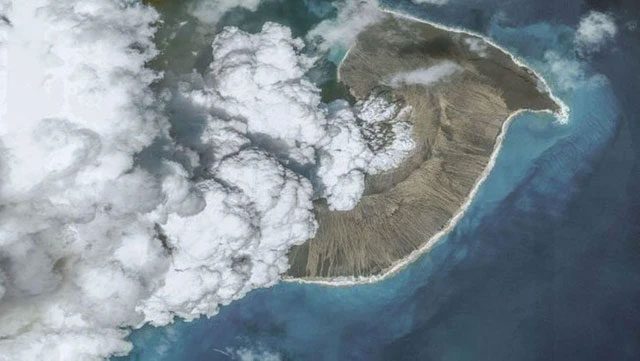Three colossal “hell chambers” have merged, playing a role as either a catalyst or consequence of the horrific events in the South Pacific in 2022.
The unsettling changes of structures beneath the Pacific have just been confirmed as the cause of the Tonga volcanic eruption in 2022, which triggered the most intense lightning storm ever recorded and tsunami waves as tall as a 30-story building.
The eruption was felt worldwide, posing challenges for scientists in understanding its causes and predicting future events.
A study recently published in the journal Science Advances has “lifted a corner of the veil.”

The Tonga eruption in 2022 shook the Pacific – (Photo: MAXAR).
According to Live Science, the authors mapped subtle changes in gravitational forces in the waters surrounding the Hunga Tonga and Hunga Ha’apai islands of the Kingdom of Tonga before and after the eruption.
“I am thrilled that we could actually visualize a relatively large magma system using these methods” – said lead author Helene Le Mevel from the Carnegie Institution for Science (USA).
They identified three “hell chambers,” which are magma reservoirs located just beneath this area.
Two of these deep magma chambers, at depths of 2 km and 10 km respectively, are believed to have connected after the Tonga eruption.
They found that the Tonga eruption released approximately 30% of the magma – equivalent to 9 km3 – from a shallow reservoir, causing the volcanic roof to collapse into a 850-meter deep pit, creating a new crater.
As pressure in the central reservoir decreased, magma stored in the deeper northern reservoir may have burst through the crust and supplemented the central reservoir, opening a new magma pathway between the two chambers.
It is also possible that magma from a third, gas-rich reservoir deeper within the Earth’s crust rose to the central chamber through a previously opened pathway, further intensifying the eruption.
The research team estimates that the two main chambers – the first and second magma reservoirs – still contain about 26 km3 of magma, enough to fill 10 million Olympic-sized swimming pools.
They could potentially cause future eruptions through newly created or expanded connecting channels.
However, the initial cause of the eruption – why the aforementioned “hell chambers” chose to erupt simultaneously in 2022 – remains a mystery.
Prior to the 2022 eruption, a significant eruption occurred in 2015, creating a conical landmass between the Hunga Tonga and Hunga Ha’apai islands. The 2022 eruption split that cone in half.


















































